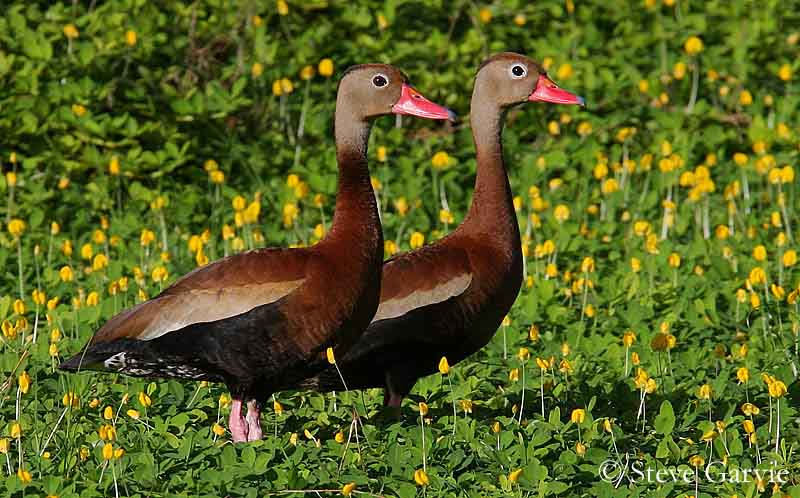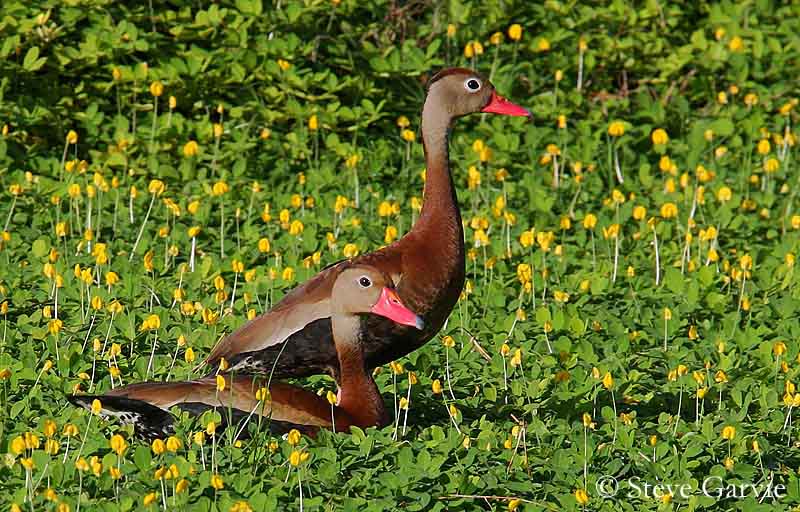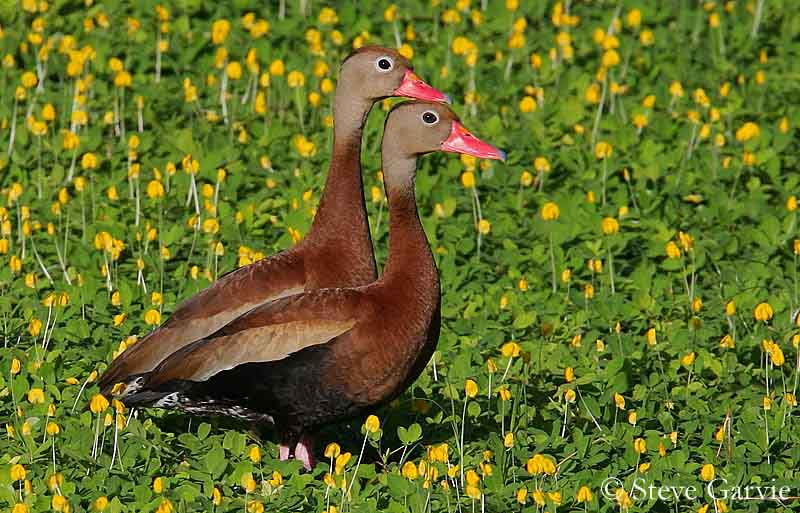
Black-bellied Whistling Duck
Dendrocygna autumnalis
Anseriforme Order – Anatidae Family
BIOMETRICS:
Length: 48-53 cm ; Wingspan: 94 cm ; Weight: 652-1020 g
LONGEVITY: up to 8 years
DESCRIPTION:
This species, as other whistling ducks, is more closely related to geese and swans than to ducks. They have long neck and legs, and broad wings, and both sexes are similar.
When in flight, Black-bellied Whistling-Duck has training wings and rounded wings, making it bigger than it is. Its red bill and legs, and the large white wing patch help to identify the species, and make the difference with the Fulvous Whistling Duck which lacks red bill and black belly.

Black-bellied Whistling-Duck has tawny-brown to brown-cinnamon upperparts, turning black on rump and uppertail coverts. Upper wings show a broad white stripe, conspicuous in flight. Flight feathers are black.
Underparts are paler. Lower neck and chest are tawny-brown. It has black belly and flanks. Undertail coverts are mottled black and white. Underwings are blackish.
Head and upper neck are grey. Crown is dark brown. We can see a dark vertical hind neck stripe. Bill is bright pink-red, often yellowish at base. Eyes are dark brown, with conspicuous white eye ring. Legs and webbed feet are bright pinkish-red.
Both sexes are similar.
Juvenile is paler, with grey bill, legs and feet. It has duller plumage than adults, with sooty-brown belly and flanks. It reaches its adult plumage at 8 months of age.
Very young birds have very paler belly, with indistinct transversal bars.
We find two subspecies:
Dendrocygna autumnalis discolor, with grey band on breast, between brown neck and black belly;
Dendrocygna autumnalis autumnalis, different in size.

VOICE: SOUNDS BY XENO-CANTO
Black-bellied Whistling-Duck’s call is a squealing “pe-chee”. Near the nest, parents utter high-pitched, rapid piping and twittering whistles. In flight, they give high piping whistles “pi-yih pyi-pyi” or “chee twee WEE wee-wee…”
HABITAT:
Black-bellied Whistling-Duck lives in wooded marshes, swampy forests, flooded fields and lagoons. It avoids lakes, except with shallow water areas near the shores.
They need waters with dense vegetation for feeding, and close trees for nesting. We can find them from sea level to 1500 metres of elevation.
RANGE:
Black-bellied Whistling-Duck breeds in extreme South of United States (Texas, Arizona, and Louisiana) and also into Central and South America to northern Argentina. There is a population in Florida.
It winters from southern Texas southwards. They are resident in Florida. Northern populations may be migratory, moving southwards, but most of populations are resident in their range, apart some local movements according to the food resources.
BEHAVIOUR:
Black-bellied Whistling-Duck is often seen perched on trees or shrubs.
It feeds on vegetal matter by grazing on the ground, and also dabbling in shallow waters. They feed on submerged vegetation, wading in shallow water. In Mexico, they are often seen gleaning in harvested corn fields.

This species is largely nocturnal, feeding and migrating at night. It rests during the day in mudflats and sandy areas, perched on low branches above water.
It is highly gregarious outside of breeding season, feeding in large flocks of up to several hundreds of individuals.
This species moults after breeding, being unable to fly for 30 to 40 days. Birds become shy and secretive, remaining hidden among vegetation in large marshes.
Pairs stay together for numerous years, as geese and swans. They nest on trees, in cavities, but also in nest boxes, and sometimes on the ground among reeds. Pairs nest in the same place year after year.
FLIGHT:
Black-bellied Whistling-Duck flies mainly in the morning and in the evening. They have fast flying ability, but generally, they fly slowly, in large noisy flocks.
REPRODUCTION:
Black-bellied Whistling-Duck nests in tree cavities (oaks, willows and mesquite trees) or nest-boxes, at 8 to 10 feet above the ground. It also may nest on the ground. When nest is in cavity, there is no lining with down or any other soft materials. When nest is on the ground, birds build a shallow cup with woven grasses, at base of thick vegetation as a cactus, or among reeds.
This species performs egg dumping, with very numerous eggs in the same nest, from several females. Generally, these nests are abandoned and eggs are lost.

Female usually lays 12 to 16 whitish eggs, one per day. Incubation lasts about 12 to 16 days, shared by both parents. Precocial chicks are yellow with black spots. They leave the nest very soon after hatching, within two days, and they are able to feed themselves. But they remain with parents for up to two months. At this time, they can fly. However, they may remain in family groups for up to six months.
This species produces only one brood per season, sometimes two if first is lost.
DIET:
Black-bellied Whistling-Duck feeds mainly on plant matter, aquatic plants, grass and grain. It also consumes insects and molluscs.

PROTECTION / THREATS / STATUS:
Black-bellied Whistling-Duck populations are increasing in United States, and they are abundant. This species damages cultivated areas in Mexico, and necessary measures must be taken to control populations.
Healthy coastal wet areas and nest boxes benefit this species.
Nests on the ground are preyed upon by rats and wolverines.
Fr: Dendrocygne à ventre noir
All : Rotschnabel-Pfeifgans
Esp : Suirirí Piquirrojo
Ital : Dendrocigna beccorosso
Nd : Zwartbuikfluiteend
Russe : Чернобрюхая древесная утка
Sd : Svartbukig visseland
Photographs by Steve Garvie
His website: RAINBIRDER Photo galleries
Text by Nicole Bouglouan
Sources:
HANDBOOK OF THE BIRDS OF THE WORLD vol 1 by Josep del Hoyo-Andrew Elliot-Jordi Sargatal - Lynx Edicions - ISBN: 8487334105
A GUIDE TO THE BIRDS OF MEXICO AND NORTHERN CENTRAL AMERICA by Steve N. G. Howell, Sophie Webb - Oxford University Press - ISBN: 0198540124
All About Birds (Cornell Lab of Ornithology)
Arthur Grosset's Birds (Arthur Grosset)
What Bird-The ultimate Bird Guide (Mitchell Waite)
Wikipedia (Wikipedia, The Free Encyclopedia)